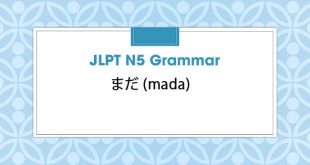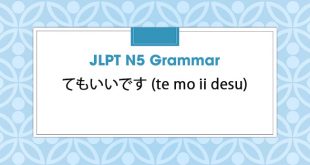はもとより (wa moto yori) Meaning: also; let alone How to use the: Noun + はもとより/はもちろん + Noun Explain: Offer things that are natural to express the meaning “not only that but also more important or lighter things”. Example sentences: 1, 寿司はもとより、すき焼きも彼は食べられない Sushi wa moto yori, sukiyaki mo kare wa tabe …
Read More »Grammar
JLPT N3 Grammar: に反して (ni hanshite)
に反して (ni hanshite) Meaning: against; contrary to; in contrast to How to use the: Noun + に反して/に反する Explain: Describe the opposite of .., contrast with expectations, expectations Example sentences: 1, 年初の予測に反して、今年は天候不順の年となった。 Nensho no yosoku ni hanshite, kotoshi wa tenkō fujun no toshi to natta. Contrary to expectations earlier this year, …
Read More »JLPT N3 Grammar: というと (to iu to)
というと (to iu to) Meaning: if it were the case that…, then certainly; if one were to speak of… then certainly . How to use the: Noun + というと/といえば Explain: From a remembered topic, think of Example sentences: 1, 韓国ドラマというと「冬のソナタ」を思い出すという人が多い。 kankoku dorama to iu to fuyu no sonata o omoidasu …
Read More »JLPT N5 Grammar: ので (node)
ので (node) Meaning: because of; the reason is that; given that How to use the: Verb + ので Noun + なので いadj + ので なadj + なので Explain: Describing the objective reason, naturally, of course lead to such. When using 「の で」, you will show a soft and soft way …
Read More »JLPT N5 Grammar: や (ya)
や (ya) Meaning: and How to use the: Noun + や + Noun Explain: The auxiliary 「や」 is used when we want to list nouns. The adjective 「や」 is used to list some typical subjects (two or more nouns). We can use the adjective 「など」 at the end of a …
Read More »JLPT N5 Grammar: まだ (mada)
まだ (mada) Meaning: still; not yet How to use the: まだ + Verb Explain: Describe an action that is unfinished but intended to do. Example sentences: 1, ご飯を食べましたか? いいえ、まだ食べていません。 Gohan o tabemashita ka? iie, mada tabete imasen. Have you eat yet? Have not eat 2, この本は、まだ読んでいませんか? いいえ、まだです。 Kono Moto wa, mada yonde …
Read More »JLPT N5 Grammar: てもいいです (te mo ii desu)
てもいいです (te mo ii desu) Meaning: You can do… ; You may do How to use the: Verb (て form) + もいい (です) な-adjective + で + もいい (です) Noun + で + + もいい (です) Explain: This sentence pattern is used to signify permission to do something. If this …
Read More »JLPT N2 Grammar: 最中に (saichuu ni)
最中に (saichuu ni) Meaning: while; during; in the middle of How to use the: Verb-てform + いる最中(に) Noun + の最中(に) Explain: The description of an action in progress is have another action Example sentences: 1, 大事な電話の最中に、急にお腹が痛くなってきた。 Daijina denwa no saichuu ni, kyū ni onaka ga itaku natte kita. During an …
Read More »JLPT N2 Grammar: ことはない (koto wa nai)
ことはない (koto wa nai) Meaning: here is no need to; there is no possibility that How to use the: Verb-dictionary form + ことはない Explain: expresses there is no need for something. It can be used after any verb to express there is no need for that action. Example sentences: 1, …
Read More »JLPT N2 Grammar: ことか (koto ka)
ことか (koto ka) Meaning: how…!; what…!; emphasis; How to use the: Phrase + ことか Explain: ことか (koto ka) is used to place strong emphasis on something. Example sentences: 1, つまらない話を3時間も聞かされる身にもなってください。どれほど退屈なことか。 Tsumaranai hanashi o 3-jikan mo kikasa reru mi ni mo natte kudasai. Dorehodo taikutsuna koto ka. He tried to put himself …
Read More » Learn Japanese Free Learn Japanese Free
Learn Japanese Free Learn Japanese Free










